

How clean are our rivers? Fiona Proffitt investigates the state of New Zealand's freshwater resources and the solutions science can offer As New Zealand tries to squeeze maximum value out of its natural resources, conflicts over water are coming to a boil. We’re fast approaching water resource limits in some parts of the country, and pollution issues are threatening our clean, green brand. Despite a comprehensive clean-up of dirty ‘point-source’ discharges in the 1990s, water quality in many of our lakes and rivers is still declining. The cause this time is ‘diffuse-source’ pollution associated with intensive land use, particularly pastoral farming. So how do we balance the drive to grow our economy with the need for clean water? These are the kinds of issues exercising the Land and Water Forum, a stakeholder group charged with finding a collaborative solution to water resource issues. Riparian management: how well are we doing?
Stephanie Parkyn Rob Davies-Colley How effective are riparian zones at protecting streams from the effects of land-use change?
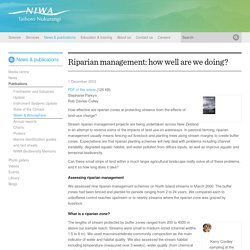
Stream riparian management projects are being undertaken across New Zealand in an attempt to reverse some of the impacts of land use on waterways. In pastoral farming, riparian management usually means fencing out livestock and planting trees along stream margins to create buffer zones. Expectations are that riparian planting schemes will help deal with problems including channel instability, degraded aquatic habitat, and water pollution from diffuse inputs, as well as improve aquatic and terrestrial biodiversity.
Can these small strips of land within a much larger agricultural landscape really solve all of these problems, and if so how long does it take? Assessing riparian management We assessed nine riparian management schemes on North Island streams in March 2000. What is a riparian zone? Some lessons It won’t happen overnight! Managing nitrogen in the Lake Taupo catchment. By Bill Vant and Jon Palmer More than 10 years ago, the Waikato Regional Council became concerned about the effects of increasing catchment loads of nitrogen on the water quality of Lake Taupo.
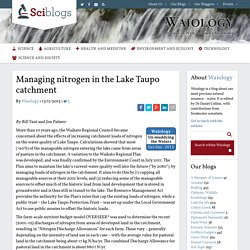
Calculations showed that most (>90%) of the manageable nitrogen entering the lake came from areas of pasture in the catchment. A variation to the Waikato Regional Plan was developed, and was finally confirmed by the Environment Court in July 2011. The Plan aims to maintain the lake’s current water quality well into the future (“by 2080”), by managing loads of nitrogen in the catchment. It aims to do this by (1) capping all manageable sources at their 2001 levels, and (2) reducing some of the manageable sources to offset much of the historic load from land development that is stored in groundwater and is thus still in transit to the lake. Each farm in the catchment has now been issued with an individual “consent to farm” that specifies the Discharge Allowance for it.
Related. Land, Air, Water Aotearoa (LAWA) - Lake Taupo. Ngati Tūwharetoa are the kaitiaki of the lake and hold legal title to the lakebed and tributaries.

More than 30 rivers and streams flow into the lake, with only one outlet, the Waikato River. Lake Taupo water quality plan hits goal - Rotorua Daily Post - Rotorua Daily Post News. A joint Government and council initiative to reduce nitrogen leaching into Lake Taupo by 20 per cent, or 170 tonnes per year, has achieved its goal three years ahead of schedule, Environment Minister Dr Nick Smith announced today.
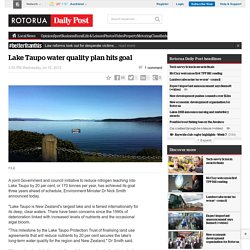
"Lake Taupo is New Zealand's largest lake and is famed internationally for its deep, clear waters. There have been concerns since the 1990s of deterioration linked with increased levels of nutrients and the occasional algal bloom. Check out this awesome video put... - Great Lake Taupo, NZ. How land use affects Lake Taupō. On this page: Kefy points, Taupō’s changing catchment, increased nitrogen in lake water, What could this mean for the lake’s future?
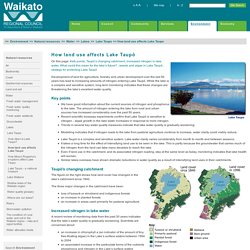
Taupo plan could be used at other lakes. Farmers near some of New Zealand's most polluted waterways could have their stock numbers capped.
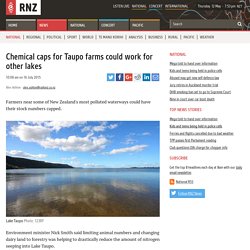
Lake Taupo Photo: 123RF Environment minister Nick Smith said limiting animal numbers and changing dairy land to forestry was helping to drastically reduce the amount of nitrogen seeping into Lake Taupo. He said the changes were working well there, and could be used to turn around other dirty lakes and rivers. Nitrogen is largely a by-product of farm animals and for the past seven years the Lake Taupo Protection Trust has used an $80 million funding pot to get farmers to reduce their output of the chemical. That meant buying land, helping farmers transition away from dairy and setting nitrogen caps that limited how many animals farms could have.
Strategy. Lake Taupō - a national treasure. On this pafge: How clean is the lake?
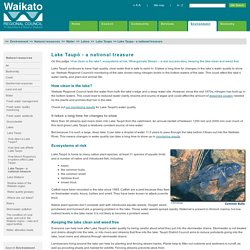
, ecosystems at risk, Whangamata Stream – a real success story, keeping the lake clean and weed free Lake Taupō continues to have high quality, clear water that is safe to swim in. 2020 Taupo nui a Tia Action Plan. Lake Taupo Protection Trust - Te Wai, Te Iwi. New Zealand's largest lake, Taupo-nui-a-tia, is a national treasure.

Renowned worldwide for its deep blue waters, Lake Taupo lies at the heart of a tourism hub. But more than its economic value is the special significance it holds for many, particularly Ngati Tuwharetoa, the iwi with mana whenua in the Lake Taupo catchment. Mike Barton: Saving Lake Taupo - a World First. Managing Lake Taupo water quality. Managing Lake Taupo water quality Lake Taupo is a large, near pristine lake, highly valued for its crystal blue waters and dramatic vistas.

Taupo’s excellent water quality is derived from extremely low levels of plant nutrients and phytoplankton. Unlike many other lakes, the availability of nitrogen, rather than phosphorus, limits phytoplankton growth in Taupo – so increased nitrogen flows from rural land use and urban growth in the catchment promote phytoplankton growth, threatening the high water quality of the lake.
Nitrogen flows from lakeshore settlements also encourage growth of some types of nuisance weeds and proliferations of algae along shorelines. Declining water quality is measurable, and is a source of concern to the community. The management proposal is nearly complete and should be available for public discussion in November this year. Tony Petch [ Tony.Petch@ew.govt.nz ] Resource Information Group Manager, Environment Waikato. Wastewater - Taupo District Council. We operate wastewater collection networks and treatment plants and ensure the discharges are appropriately treated returned safely to the environment.

What is wastewater? Each time you flush the toilet, pull the plug from a sink, or have a shower, the wastewater drains into a sewer drain on your property. Wastewater includes organic matter such as human waste, food scraps, fats, oil and grease, and other debris such as sand, grit and plastic. Wastewater is also generated from commercial and industrial premises. Our goals in providing a public wastewater system. Lake Taupō. On this page: Water quality in Lake Taupō , looking after Lake Taupō Lake Taupō is a national treasure. It is a clean, clear lake, water quality is good for swimming and for the plants and animals that live in it. Target reduction of nitrogen into Lake Taupo met.
Agreements to reduce the amount of nitrogen entering into Lake Taupo have been reached in a bid to improve and maintain water quality. Lake Taupo Photo: 123rf Contracts with land owners to change the way land is used have been signed which will in time reduce nitrogen leaching by 20 percent or 170 tonnes a year. Money from an $80 million fund set up to protect the lake has been used to purchase some land and turn dairy farms into forestry and to help farmers find new ways to farm such as reducing stock numbers. 7500 hectares of farmland will be converted to forestry. Lake Taupo protection project on track. The ground-breaking programme to reduce pollution in Lake Taupo from nitrogen leaching is on track to reach its target.
And as part of that Waikato Regional Council has agreed to a long-term monitoring arrangement for the scheme. The Lake Taupo Protection Project has reduced nitrogen going into the lake, mainly from livestock farming, by more than 150-tonnes a year. It's done that through measures that include a nitrogen capping and trading system and compensating farmers to change land use. The aim is to reduce nitrogen levels by 170.3 tonnes a year, by the end of next year. Lake Taupo. Waikato Regional Council has agreed to sign a deed with the other partners in the scheme, Taupo District Council and Lake Taupo Protection Trust, to monitor its effectiveness. ProtectingLakeTaupopublication.